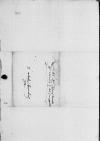List #2341
Sigmund von HERBERSTEIN do Ioannes DANTISCUSCracow (Kraków), 1540-09-09
| odebrano Graudenz (Grudziądz), 1540-10-03 Rękopiśmienne podstawy źródłowe:
Pomocnicze podstawy źródłowe:
Publikacje:
| ||||||||||||
Tekst + aparat krytyczny + komentarz Zwykły tekst Tekst + komentarz Tekst + aparat krytyczny
Reverendissimo domino, domino
Reverendissme Domine, domine observandissime. Post servitiorum meorum commendationem.
Etsi iam diu ad Vestram Reverendissimam Dominationem non scripserim, in causa est
Ex
Vestrae Reverendissimae Dominationis obsequentissimus
[1 ] Since June 12, 1540 to July 28 a colloquium of Protestants and Catholics was in session, called there by Ferdinand I, with the participation of great theologians (including Martin Bucer and John Calvin), electors and dukes. The aim of the meeting was to pacify religious relations in the Reich and, in accordance with the intentions of Emperor Charles V, facilitate its unity in the face of the Turkish threat. One of Ferdinand I’s political objectives in calling this congress was also to obtain final recognition for his title of king of the Romans from the leader of the Schmalkaldic League – Johann Friedrich, Saxon elector, who did not come to Hagenau, however, nor did he send a representative. The colloquium did not bring the desired results. In July, an epidemic broke out in Hagenau, and soon after the colloquium opened, when news came of the death of János I Zápolya (d. July 21, 1540), Ferdinand I set off towards Vienna, where he arrived on August 8, ordering the war alert to the court (cf. cf. Lexutt p. 32-38 ⌊Lexutt, p. 32-38cf. Lexutt p. 32-38 ⌋; cf. FICHTNER p. 115-117 ⌊Fichtner, p. 115-117cf. FICHTNER p. 115-117 ⌋; cf. KOHLER 2003 p. 203-204 ⌊Kohler II, p. 203-204cf. KOHLER 2003 p. 203-204 ⌋; ⌊ No. 651, p. 87-88 No. 32, p. 30-31, No. 380, p. 136-139 ⌋, cf. VOIGT 1857 No. 380, p. 136-139 ⌊Voigt, p. 278cf. VOIGT 1857 No. 380, p. 136-139 ⌋)
[2 ] Namely to the Grand Duchy of Lithuania and its capital – Vilnius (cf. cf.
[3 ] It is hard to resolve unequivocally whether Herberstein is referring to the text of Rerum Moscoviticarum commentarii (Vienna 1549) then being prepared for printing, which the editor, Lucas Guettenfelder (Agathopedius) referred to simply as Moscovia at this time, or – as the next sentence of the letter could suggest – he means a map that may have been the initial version of the map prepared by Augustin Hirschvogel for the first edition of Commentarii. This map, titled Moscovia Sigismundi liberi baronis in Herberstein... , was published with the date 1546 (see Plate 5). For more about the cartographic issues in this letter and the terminology that causes problems with interpretation, see Introduction, p. !!!
[5 ] Most likely a reference to the extraordinarily impressive elk antlers that strongly intrigued Herberstein at the time in connection with his zoological investigations and his work on the appropriate chapter of Rerum Moscoviticarum commentarii (De feris). The main aim was to explain the differences between a bison and an auroch, as the two animals were usually confused in Western Europe at the time. (cf. cf.
[7 ] The Latin equivalent of the hereditary title Freiherr (Lat. Liber baro) that Ferdinand I granted to the Herbersteins on January 24, 1537 (see cf. HERBERSTEIN 1855 p. 319-321 ⌊Herberstein 1855, p. 319-321cf. HERBERSTEIN 1855 p. 319-321 ⌋)

